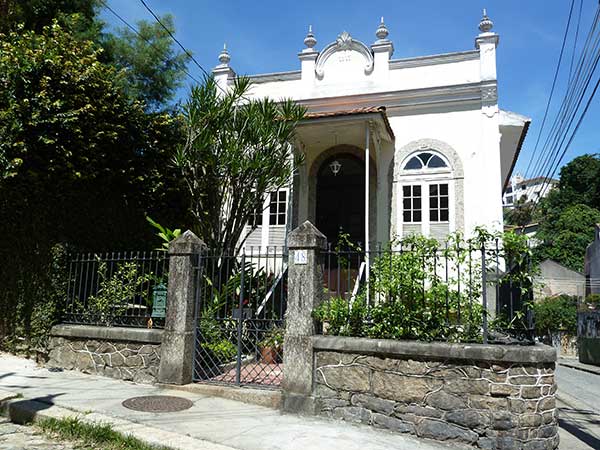Private tour to Santa Teresa neighborhood in Rio de Janeiro

Born on a hill, with a magnificent view of the city and connected to the center by a charming tram, Santa Teresa has for decades attracted plastic artists, writers, photographers, designers and, of course, tourists. The comings and goings of locals and visitors on its slopes do not interfere with the atmosphere of an inner city in the neighborhood, but transform it into a kind of cosmopolitan village, whose narrow streets, with old houses and well-kept gardens, hide workshops, bars, inns and a wide variety of cultural attractions.
Get the most out of the city: book a Rio de Janeiro private tour
History of Santa Teresa neighborhood
Long before earning the well-deserved nickname “Montmartre carioca,” Santa Teresa made history by improving the city’s quality of life. It appeared in the 18th century from the construction of the convent of Santa Teresa, when it was still called Desterro, in homage to Antônio Gomes do Desterro, one of the first inhabitants of the hill. Later, it welcomed a large number of European immigrants, quickly becoming one of the city’s most chic neighborhoods, with several houses and palaces of eclectic architecture.
In the 1850s, due to its high geographical location, the neighborhood was one of the least affected by the great yellow fever epidemic. With the arrival of the electric tram in September 1896 and improvements to the sidewalk, the palaces were multiplied and the first hotels were inaugurated. The hill has become a neighborhood and it becomes home to many artists and intellectuals. Pixinguinha, Carmem Miranda, Bibi Ferreira and Propio Ferreira were just a few of the famous characters who lived there.
The neighborhood’s human development index in 2000 was 0.878, the 34th highest in the municipality of Rio de Janeiro. The Santa Teresa district does, however, have some famous favelas such as Fallet and Morro dos Prazeres.
The charming old streets of the Santa Teresa district are full of historic houses and art studios and are a special attraction. Let yourself walk through them to discover and feel the inner climate of the neighborhood – but get ready, as they are very steep. As you are on a hill, many streets are real gazebos with beautiful views of SugarLoaf and Guanabara Bay.
Ruins Park
Located at the top of the hill, the park is what remains of Laurinda Santos Lobo’s eclectic palace, which hosted some of the largest and most famous festivals of the high society of Rio and which hosted artists such as Villas-Lobos and Tarsila do Amaral. However, in the 1940s, after Laurinda’s death, leaving no heirs, the house was abandoned and much of the original structure was lost.
It was not until 1997 that the ruins of the castle were restored and materials such as glass and iron were placed to give access to the site. Today, in addition to art exhibitions and musical performances, the park offers one of the best vistas in the city.
Chácara do Céu Museum
The 1957 house, a beautiful project by Wladimir Alves de Sousa, brings together the heritage of the former owner, industrialist and collector Raymundo Castro Maya. Engravings and paintings by European artists such as Seurat and Miró, Brazilian modernists such as Guignard, Di Cavalcanti, Antônio Bandeira and Portinari, as well as a Brazilian collection of works by Rugendas, Chamberlain, Taunay and a large collection of Debret engravings, are part of the collection. The gardens of the house are from Burle Marx.
Museum House of Benjamin Constant
Benjamin Constant, one of the most important leaders of the campaign for the Republic in Brazil, lived for a few years in the house erected around 1860. The space was transformed into a museum in 1982, recreating the family atmosphere of the illustrious resident, with photographs, furniture, sculptures, clothing and personal items.
The tram
Santa Teresa is one of the only neighborhoods in Rio de Janeiro where the tram still operates as public transport and is, of course, the most picturesque way to move around the neighborhood. Installed in 1872 to connect Santa Teresa to the downtown via the Arcos da Lapa, the trams emerged as an alternative to move around the neighborhood without having to face the steep slopes.
The first trams are painted green, silver and blue, but were repainted yellow following complaints from residents that the trams are almost imperceptible amid the vegetation.
Much of the history of trams can be seen at the Tram Museum, which exhibits various pieces referring to this means of transport. You can see old tickets, drivers’ uniforms and original watches, as well as models and replica trams.
Convent of Santa Teresa
Founded by the mother Jacinta de São José, the work on the convent began in 1750 and was completed several years later, starting with the project of the military engineer José Fernandes Pinto Alpoim, who was also responsible for the construction of the Arcos da Lapa – the proximity to the aqueduct allowed the convent to have a regular supply of water.
Largo do Curvelo
The vast historical area pays homage to Baron de Curvelo, a famous former resident of the area. Surrounded by beautiful buildings and the tram stop, the sea is still home to artists and one of Rio’s most famous carnival street band: Carmelitas.
Church of Saint Teresa of Jesus
The church was inaugurated on October 14, 1917 and has a French Gothic style. It is dedicated to Saint Teresa of Jesus, a Spanish saint canonized in 1622.
Why take a private tour while in Rio?
Some of the advantages of taking a private tour in Rio de Janeiro are:
- Save time
- Feel safer
- Avoid long lines
- Learn about the sites
- Get insider’s important information and tips
